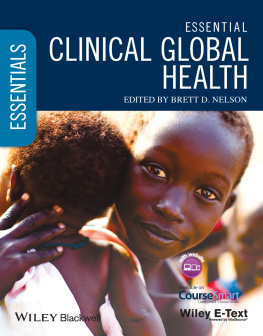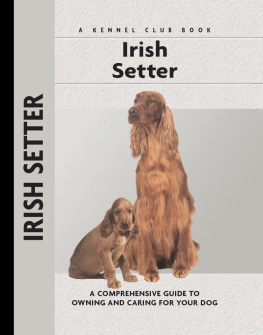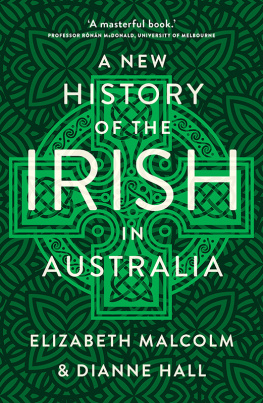Irish Nationalists and the Making of the Irish Race
Irish Nationalists and the Making of the Irish Race
Bruce Nelson
P RINCETON U NIVERSITY P RESS
P RINCETON AND O XFORD
Copyright 2012 by Princeton University Press
Published by Princeton University Press, 41 William Street, Princeton, New Jersey 08540
In the United Kingdom: Princeton University Press, 6 Oxford Street, Woodstock, Oxfordshire OX20 1TW
press.princeton.edu
All Rights Reserved
Library of Congress Cataloging-in-Publication Data
Nelson, Bruce, 1940
Irish nationalists and the making of the Irish race / Bruce Nelson.
p. cm.
Includes bibliographical references and index.
ISBN 978-0-691-15312-4 (hardcover : acid-free paper) 1. IrelandHistory. 2. National characteristics, Irish. 3. IrishEthnic identity. 4. RaceHistory. I. Title.
DA925.N45 2012
320.5409415dc23 2011047701
British Library Cataloging-in-Publication Data is available
This book has been composed in Minion Pro
Printed on acid-free paper.
Printed in the United States of America
10 9 8 7 6 5 4 3 2 1
FOR DONNA
For so many reasons, and
in memory of Joan (19312007)
Contents
Illustrations
Acknowledgments
When I finished my last book, which was published in January 2001, I vowed that the next one would be shorter and would be published much more quickly than its predecessor. Now its a decade later, and Im just completing that next book. But I try to look at the bright side. Over a period of ten years, I have made many friends and accumulated many debts. Now I can finally take the opportunity to thank some of the people whose kind assistance along the way has been indispensable.
For someone who was trained in U.S. history and who has written two books on American labor history, this has been a bold but risky undertaking. I wandered onto someone elses terrain, and the good news is that I have been welcomed by some of the very best historians in the field of Irish history. I must begin with my friend and mentor Kevin Whelan, who is one of the most brilliant scholars and generous individuals I have met in my lifetime. It would take up too much space to enumerate the ways large and small in which Kevin has facilitated the evolution of this book. But I must tryhowever inadequatelyto express my gratitude.
Perry Curtis has also been a generous ally and friend. His Apes and Angels, first published in 1971, remains the starting point for studying the evolution of English stereotypes of the wild and savage Irish. Perry has read many of my chapters with great care and critical acumen; he has also shared many a story over our semiregular get-togethers at the Dirt Cowboy Caf in Hanover, New Hampshire. Its nice to have one of your most knowledgeable critics as a neighbor.
I owe a word of thanks to a number of other colleagues and friends as well. For nearly two decades Alex Bontemps has taken on the task of reading just about everything I have written, and his friendship and critical insight have been a special gift. David Brody, my mentor in American labor history, read several chapters and offered a number of critical suggestions that I probably should have taken on board more than I did. Leslie Butler provided detailed and very astute criticisms of my chapters on Ireland, slavery, and abolition. Tim Meagher read several chapters and challenged me on an important point of interpretation. In retrospect, Im grateful that he stood his ground. Brian Hanley and I have shared many meals, ideas, and resources ever since we first met in Dublin in the summer of 2002. Irene Whelans generosity and her unrelenting belief in my work have provided great comfort and reassurance at critical moments along the way. Thanks also to the staff of Notre Dames Keough-Naughton Irish Studies Centre in Dublin for their unfailing warmth and generosity; to Seamus Deane, Luke Gibbons, Joe Cleary, and Breandn MacSuibhne; and to Abby Bender, Bob Bonner, Vincent Comerford, David Gleeson, Robert A. Hill, Ely Janis, Kevin Kenny, Joe Lee, Mic Moroney, Angela Murphy, Orla Power, Matthew Stout and the Byrne Perry Summer School, Paul Townend, and Clair Wills.
In writing this book I ventured onto the terrain of South African history and found a great tutor in Ben Carton of George Mason University. In reading and commenting on my two South Africa chapters, Ben went far beyond the ordinary obligations of collegiality. I am also grateful to Lindsay Braun, of the University of Oregon, who patiently has tried to walk me through the complex and contextual meanings of such elementary terms as Boer and Afrikaner and even black and white in nineteenth-century South Africa.
One of the most enjoyable benefits of working in the field of Irish history has been the opportunity to spend substantial amounts of time in Ireland for the last decade. When it comes to the generous hospitality I encountered there again and again, I must offer a special word of thanks to Andrew Pilaro. In 2003 Andrew gave me a place to stay in Dublin at a point when I was ramping up my research on this project. The opportunity to spend weeks at a time in the citys indispensable research libraries, and to have a comfortable place to come home to every night, was a great gift. I will be forever grateful to Andrew, and also to Anita Whelan, who helped me out of many a jam during my sojourns in Georgian Dublin. A word of thanks, as well, to Tony Pilaro and Robert Binswanger, whose initiative helped to make it all possible.
I must also express my gratitude to Dermot and Ann Keogh in Cork city for their unfailing kindness and generosity. Dermot, the head of the history department at University College Cork, arranged for me to spend the autumn of 2002 at UCC, where I often had the opportunity to share a meal with the Keogh family. While I was in Cork, Gillian Smith (now Gillian Doherty) became a good friend, and she made sure that I never lacked for things to do in my spare time. Through Gill I was able to meet Gabriel Doherty, and David and Anne Smith, who are every bit as warm and generous as their daughter.
And then there is my cousin Mary Rodgers, who lives in Ballynahinch, County Down. I have visited Mary (and, until 2002, her brother, Pat) more times than I can count by now, and always there is a cup of tea, a good meal, a comfortable place to sleep, and more family stories. Im grateful to Mary for being there for me and for many other family members as well.
It is a pleasure to thank the staffs of a number of research librariesfirst and foremost the National Library of Ireland in Dublin, which became a kind of home away from home for me. It was always a privilege to work in the NLIs main reading room and manuscripts reading room and to take advantage of the innumerable resources that are available at both sites. I must also thank the staff at the British Library, in London, where I spent many productive and enjoyable days during the autumn of 2003, and again in the fall of 2008. The British Library also became a kind of home away from home, and desk number 3094 in Humanities 2 proved to be an amazingly congenial workplace. Thanks also to the staffs of the Manuscripts and Archives Research Library, Trinity College Dublin; the University College Dublin Archives; the Manuscripts and Archives Division, New York Public Library; and the Chicago Historical Society.
For indispensable assistance with illustrations, I am most grateful to Dennis Grady at the Dartmouth College Library; Berni Metcalfe at the National Library of Ireland; Seamus Helferty at the University College Dublin Archives; Sharon Sutton and Ellen OFlaherty at Trinity College Dublin; Moira Fitzgerald at the Beinecke Rare Book and Manuscript Library, Yale University; Anne Moore at the Special Collections and University Archives, W.E.B. Du Bois Library, University of Massachusetts Amherst; Sean Casey and Jane Winton at the Boston Public Library; Michael Foight, Special Collections and Digital Library Coordinator, Falvey Library, Villanova University; and Jeffrey B. Perry.

















